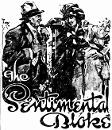 8446372745420830197.jpg
8446372745420830197.jpg
 8446372745420830197.jpg
8446372745420830197.jpg
Adapted by Raymond Longford and Lottie Lyell from C. J. Dennis's collection of poems (The Songs of a Sentimental Bloke), the story concerns Bill ('the bloke'), a Sydney larrikin who vows to abandon his life of gambling and drinking when he falls in love with Doreen (who works in a pickle factory). His reformation comes about after he has been released from gaol, having been convicted of assaulting a policeman ('stoushing a John') during a raid on a two-up game.
'Raymond Longford and Lottie Lyell’s 1919 adaptation of C.J. Dennis’s vastly popular 1915 verse novel, The Songs of a Sentimental Bloke, has long been regarded as the great classic of surviving Australian silent films, yet relatively little has been written about how text and image relate to each other within it. This article begins with a consideration of Dennis’s poems in the context of the contemporary fashion for dialect verse, which paradoxically represented comic, semi-literate speakers for the entertainment of an increasingly literate mass audience, often through popular recitals in which the magic lantern show offered an early model of incorporating poetry with projected images. It is argued that Longford and Lyell’s deployment of Dennis’s text in the form of first-person expository intertitles implies that Arthur Tauchert’s performance as Bill, the Bloke, may itself be read as a kind of filmic ‘recital’. This has implications for the different ways in which his patois has been ‘picturised’ throughout, and two scenes are analysed in detail: ‘The Play’, where Bill famously first encounters Shakespeare, and ‘The Stroot ’at Coot’, where he vanquishes a middle-class rival. Against the artifice of Dennis’s ‘larrikinese’, the film unfolds through a naturalistic style of acting and direction that, while it incorporates earlier modes of popular performance, also reimagines them into a style of comic, dramatic irony.' (Publication abstract)
Lottie Lyell had her work cut out when she agreed to appear as the love interest of The Sentimental Bloke (Raymond Longford, 1919). The film was, and has usually been admired, as a bloke-ish affair. Its reputation – it was the highest grossing Australian film during the silent era, and has been called the ‘Great Australian Film’ – has been attributed to its (male) director. Raymond Longford is revered as “the only genuine creative talent the Australian cinema has produced” and “a remarkable filmmaker” with “unique vision”. His characteristic fusion of high Victorian melodrama, natural light and outdoor shooting, pacy realism, and dynamic cinematic techniques, led to comparisons with D.W. Griffith, then the most famous film director in the world.' (Introduction)
'The Sentimental Bloke was a hugely popular multi-media phenomenon in Australia during the First World War and early interwar years. I explore the work as a heterosexual “masculine romance”: a love story expressing heterosexual romantic feeling from a masculine point of view and in a self-consciously masculine way. The Bloke phenomenon demonstrates that “ordinary” Australian men were more interested in certain forms of romantic popular culture than previously allowed. It also points to the fact that avowedly masculine constructions of romantic feeling were emerging in this period in response to criticism of elaborate Victorian-era expressions of romance on the one hand, and of commodified approaches to romantic love on the other. This point has implications for romance studies, which has paid little attention to the concept or even the possibility of masculine romance. In Australia, there was an insistent emphasis on plainness and straightforwardness as the hallmarks of a sturdily masculine approach to romance in the 1910s and 1920s. My hope is that this discussion will prompt other romance scholars to consider the particular inflexions given to masculine constructions of romance in other localities in the same period.'
Source: Abstract.